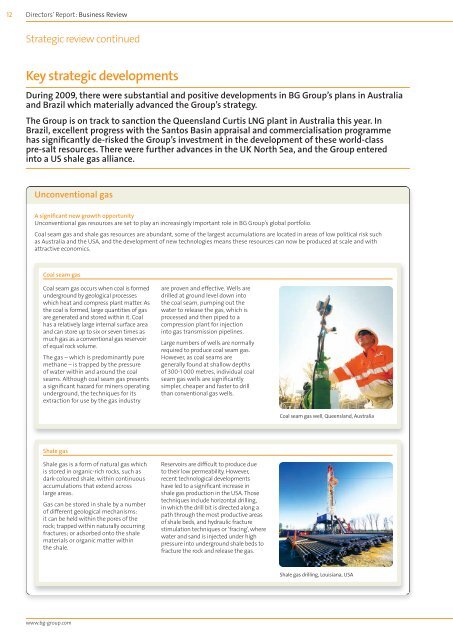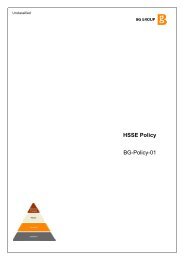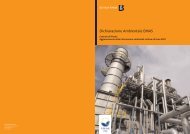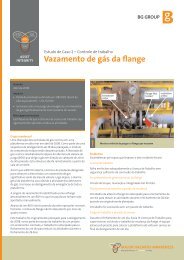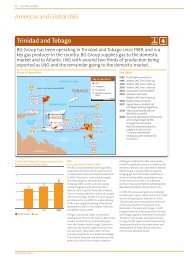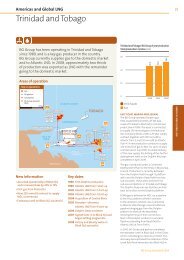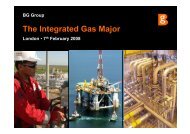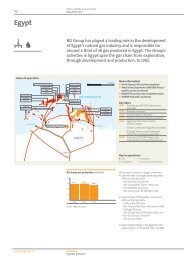Annual Report and Accounts 2009 - BG Group
Annual Report and Accounts 2009 - BG Group
Annual Report and Accounts 2009 - BG Group
Create successful ePaper yourself
Turn your PDF publications into a flip-book with our unique Google optimized e-Paper software.
12<br />
Directors’ <strong>Report</strong>: Business Review<br />
Strategic review continued<br />
Key strategic developments<br />
During <strong>2009</strong>, there were substantial <strong>and</strong> positive developments in <strong>BG</strong> <strong>Group</strong>’s plans in Australia<br />
<strong>and</strong> Brazil which materially advanced the <strong>Group</strong>’s strategy.<br />
The <strong>Group</strong> is on track to sanction the Queensl<strong>and</strong> Curtis LNG plant in Australia this year. In<br />
Brazil, excellent progress with the Santos Basin appraisal <strong>and</strong> commercialisation programme<br />
has significantly de-risked the <strong>Group</strong>’s investment in the development of these world-class<br />
pre-salt resources. There were further advances in the UK North Sea, <strong>and</strong> the <strong>Group</strong> entered<br />
into a US shale gas alliance.<br />
Unconventional gas<br />
A significant new growth opportunity<br />
Unconventional gas resources are set to play an increasingly important role in <strong>BG</strong> <strong>Group</strong>’s global portfolio.<br />
Coal seam gas <strong>and</strong> shale gas resources are abundant, some of the largest accumulations are located in areas of low political risk such<br />
as Australia <strong>and</strong> the USA, <strong>and</strong> the development of new technologies means these resources can now be produced at scale <strong>and</strong> with<br />
attractive economics.<br />
Coal seam gas<br />
Coal seam gas occurs when coal is formed<br />
underground by geological processes<br />
which heat <strong>and</strong> compress plant matter. As<br />
the coal is formed, large quantities of gas<br />
are generated <strong>and</strong> stored within it. Coal<br />
has a relatively large internal surface area<br />
<strong>and</strong> can store up to six or seven times as<br />
much gas as a conventional gas reservoir<br />
of equal rock volume.<br />
The gas – which is predominantly pure<br />
methane – is trapped by the pressure<br />
of water within <strong>and</strong> around the coal<br />
seams. Although coal seam gas presents<br />
a significant hazard for miners operating<br />
underground, the techniques for its<br />
extraction for use by the gas industry<br />
Shale gas<br />
Shale gas is a form of natural gas which<br />
is stored in organic-rich rocks, such as<br />
dark-coloured shale, within continuous<br />
accumulations that extend across<br />
large areas.<br />
Gas can be stored in shale by a number<br />
of different geological mechanisms:<br />
it can be held within the pores of the<br />
rock; trapped within naturally occurring<br />
fractures; or adsorbed onto the shale<br />
materials or organic matter within<br />
the shale.<br />
www.bg-group.com<br />
are proven <strong>and</strong> effective. Wells are<br />
drilled at ground level down into<br />
the coal seam, pumping out the<br />
water to release the gas, which is<br />
processed <strong>and</strong> then piped to a<br />
compression plant for injection<br />
into gas transmission pipelines.<br />
Large numbers of wells are normally<br />
required to produce coal seam gas.<br />
However, as coal seams are<br />
generally found at shallow depths<br />
of 300-1 000 metres, individual coal<br />
seam gas wells are significantly<br />
simpler, cheaper <strong>and</strong> faster to drill<br />
than conventional gas wells.<br />
Reservoirs are difficult to produce due<br />
to their low permeability. However,<br />
recent technological developments<br />
have led to a significant increase in<br />
shale gas production in the USA. Those<br />
techniques include horizontal drilling,<br />
in which the drill bit is directed along a<br />
path through the most productive areas<br />
of shale beds, <strong>and</strong> hydraulic fracture<br />
stimulation techniques or ‘fracing’, where<br />
water <strong>and</strong> s<strong>and</strong> is injected under high<br />
pressure into underground shale beds to<br />
fracture the rock <strong>and</strong> release the gas.<br />
Coal seam gas well, Queensl<strong>and</strong>, Australia<br />
Shale gas drilling, Louisiana, USA


